
1-4
|
ni.com
Chapter 1
NI Smart Camera Overview
LabVIEW Real-Time Module
The LabVIEW Real-Time Module combines LabVIEW graphical programming with the power
of Real-Time (RT) hardware, enabling you to build deterministic, real-time systems. You
develop VIs in LabVIEW and embed the VIs on RT targets, such as the NI Smart Camera. The
RT target runs VIs without a user interface and offers a stable platform for real-time VIs. For
more information about the LabVIEW Real-Time Module, refer to the
LabVIEW Help
.
NI Vision Development Module
The NI Vision Development Module is an image acquisition, processing, and analysis library of
hundreds of functions for the following common machine vision tasks:
•
Pattern matching
•
Particle analysis
•
Gauging
•
Taking measurements
•
Grayscale, color, and binary image display
With the NI Vision Development Module you can acquire, display, and store images as well as
perform image analysis and processing. Using the NI Vision Development Module, imaging
novices and experts can program the most basic or complicated image applications without
knowledge of particular algorithm implementations.
For information about how to use the NI Vision Development Module with the
LabVIEW Real-Time Module, refer to the
NI Vision for LabVIEW Help
.
NI Vision Acquisition Software
The NI Vision Acquisition Software CD contains Measurement & Automation Explorer (MAX)
configuration software and NI-IMAQ driver software.
Use MAX to configure the NI Smart Camera. You can set the IP address, update software on the
smart camera, configure triggering, and set up the lighting features. For more information about
MAX, refer to the
Measurement & Automation Explorer Help for NI-IMAQ
NI-IMAQ is the interface path between the application software and the smart camera.
NI-IMAQ also controls the I/O and image acquisition on the smart camera.
NI-IMAQ includes an extensive library of VIs you can call from LabVIEW. These VIs include
routines for video configuration, continuous and single-shot image acquisition, and trigger
control.
The NI-IMAQ driver software performs all functions necessary for acquiring and saving images
but does not perform image analysis. NI-IMAQ features both high-level and low-level functions.
A function that acquires images in single-shot or continuous mode is an example of a high-level
function. A function that requires advanced understanding of image acquisition, such as
configuring an image sequence, is an example of a low-level function.
For information about using NI-IMAQ to configure an acquisition, refer to the
NI-IMAQ VI
Reference Help
.















































